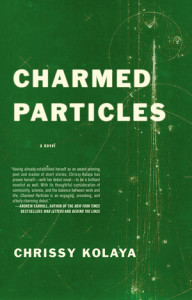What We’re Reading: Charmed Particles

 Charmed Particles by Chrissy Kolaya (Dzanc Books, 2015)
Charmed Particles by Chrissy Kolaya (Dzanc Books, 2015)
Charmed Particles is a novel about two families in the prairie town of Nicolet, Illinois. One family arrives there from India because of the particle accelerator buried underground: Abhijat Mital gets a job at the lab, his wife Sarala moves with him soon after, and they have a daughter, Meena. The other family is tied to Nicolet by Rose, descended from a long line of Illinoisians, who married “the last gentleman explorer,” Randolph Winchester. They have a daughter, Lily.
Charmed Particles is a cyclotron of a novel, introducing its characters as slow-moving atoms and accelerating them toward inevitable collision. Through most of the novel, each character seems to bob along in seclusion despite living together. Long passages—almost entire passages—are maddeningly interior. Direct interaction is rare, and in the cases it is described, it’s often in flashback, made subjective by memory and the context of the recall.
Novels are, of course, weighted toward the interior. It’s one of the formal capabilities that sets it apart from other media. Kolaya’s interiority feels like a particularly Midwestern one, though. Her characters clean, cook, take walks, and prepare for Mary Kay parties, and it’s in these moments that they obsess over the conversational minutiae of the day. They think about what they should have said, what they could have done, and if maybe they should talk about their feelings. The reader is forced to piece together what happened across recent hours or days based the bits of memory obsessed over by the people of Nicolet, Illinois. At times, I wanted to shake the characters, sit them down in a room, and force them to talk to each other.
Even the family of Indian expats suffer from this Midwestern tendency of anxious recall. This speaks to another curious aspect of Charmed Particles: the legacy of colonialism. Sarala learns about America from Our Colonial Forefathers and from Nicolet’s Heritage Village, a historical living history site that holds Revolutionary War reenactments despite being nowhere near an actual battle site. It’s alarming how quickly she buys into this benevolent narrative of her adopted country, and how easily she forgets about her mother-in-law’s recipes in favor of frozen meals and the sort of cookbook recipes that, these days, circle the internet in ironic awe.
Her husband, Abhijat, buys into a different sort of colonialism. He believes in scientific imperialism, the “religion of intellectuals” which leads him to believe that any problem can be solved with an application of science and logic. He has this in common with Randolph Winchester, whose desire to document the people of the world leads to his viewing them as a resource to be observed and not much more. On presenting to the Nicolet Ladies’ Auxiliary, he refers to the people in his slideshows as “the natives” rather than referring to them by culture, location, or by their names.
These behaviors are never explicitly championed or condemned. Only Meena is shown to suffer from and consider the racial ramifications of institutionalized colonialism. In one of the book’s most powerful segments, Meena confronts the twin terrors of puberty and racism as she pages through a hidden copy of The Secret Museum of Mankind, where people of color are described as “careless children of nature,” while her teacher stumbles through a superficial sex ed lesson. Later on, as the students prepare for their roles in the Revolutionary War Days, one of Meena’s peers calls her participation “inauthentic.” To make matters worse, their teacher admits that her presence isn’t “ideal.”
This ignores the fact that Indian immigrants have been in America since at least 1622. Also, the last battle of the Revolutionary War was fought in India. It makes sense, since India was an important British colony at the time, and it’s easy enough for us to do a quick online search to uncover this. However, the characters of Charmed Particles, being stuck in the 1980s, don’t have that benefit, so when a white teacher calls a student “less than ideal,” they had to rely on their purely physical social networks for help and comfort. Injustices had to be borne for a time; a solution wasn’t always in sight.
It’s this commitment to work in the shadow of failure that most endears me to Kolaya’s characters. They all fail in major ways, but there’s no climactic breakthrough where they reverse their failures. Instead, Charmed Particles becomes a book about living after failure and recommitting to what’s left. It’s not interested in the collision of the known particles; it looks at what comes out after they collide.
Question for readers: is it okay for issues such as colonialism and racism to be portrayed without any clear signifiers that such behavior is wrong?






Comments are closed.